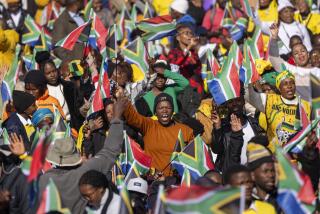S. African Blacks Protest to Honor Dead
- Share via
UITENHAGE, South Africa — Thousands of black South Africans on Friday honored those who had died in the struggle against apartheid with memorial services, protest marches and a general strike that turned one of the county’s biggest industrial centers into a ghost town.
The police clashed repeatedly with black youths, and broke up marches in central Johannesburg and Durban, using whips and tear gas.
Meanwhile, 14 people were reported killed in in-fighting among rival black political groups around the country. The deaths brought new pleas from speakers at a massive memorial rally here for blacks to put aside ideological differences and develop a united front to oppose apartheid.
‘Brother Against Brother’
“The apartheid system is trying to keep us divided and quarrelsome so that we end up fighting each other and not the Pretoria regime,” said Curnick Ndlovu, chairman of the United Democratic Front, a coalition of anti-apartheid groups, “and it is having too much success at this turning of brother against brother.”
Friday’s protests commemorated the fatal shooting of 69 blacks by police at Sharpeville in 1960 and the deaths of 20 others last year at Langa, a black township of Uitenhage, on the 25th anniversary of the Sharpeville massacre.
“We remember our comrades, the fallen in battle,” Winnie Mandela, the wife of imprisoned African National Congress leader Nelson Mandela, said in a message read to the memorial rally. “We do not accept and never will that blood will continue to flow on our side only.”
Increased black militancy was evident in other speeches. The Rev. Allan Boesak, a leading opponent of apartheid and a founder of the United Democratic Front, called on blacks to “get out and be counted in the streets so (the government) knows you are in the struggle.”
‘New Era Has Come’
In Johannesburg, Saths Cooper, president of the militant Azanian People’s Organization, told a memorial rally: “We need to take the struggle much further. Why should our people use stones against Caspirs (police armored cars) and machine guns? A new era has come to South Africa, and the ruling class is aware they can no longer oppress us.”
Heightened black militancy was dramatized by a general strike by an estimated 600,000 workers in eastern Cape province. Uitenhage and Port Elizabeth, one of the country’s most important industrial centers, became virtual ghost towns as black workers stayed home, leaving factories, shops and city streets empty.
For South Africa’s black majority, the Sharpeville anniversary has grown into a memorial day honoring the “martyrs of the struggle” against apartheid, and the deaths of 14 blacks Friday in clashes with other blacks was evidence of how “the struggle within the struggle” has escalated in recent months, accounting for almost half of the deaths reported.
Police said that seven men were killed outside Cape Town as a result of continued feuding between militant youths and conservative community leaders there.
Burned by Mob
Two blacks, including a girl, died near East London when their house along with a dozen others was set afire by a mob. And a woman, apparently suspected of collaborating with the government, was burned alive there.
In Soweto, outside Johannesburg, another woman, also thought to be working for the police, was burned to death on a pile of gasoline-soaked tires.
In the Zulu tribal homeland of Kwazulu, two policemen and a passenger were killed when the bus they were in was caught in a clash between feuding tribesmen.
The most serious clash Friday between police and blacks occurred in Durban when about 500 black and Indian students started to march through the city center to the American Consulate to protest the Reagan Administration’s continued backing of the President Pieter W. Botha’s approach of step-by-step reforms. Police used plastic whips and tear gas to break up the demonstration, and arrested 118 youths, half of them under 18.
Woman Rescued
At Johannesburg’s University of the Witwatersrand, about 100 black and white students stoned police after anti-apartheid demonstrations. A black woman accused of being a police informer was rescued by university authorities while she was being led away by angry blacks.
In downtown Johannesburg, about 200 members of the Azanian People’s Organization began a march through the streets after their memorial service at the South African Council of Churches but were quickly dispersed by riot police.
At Sharpeville itself, about 50 miles south of Johannesburg, police fired tear-gas grenades and rubber bullets to disperse about 800 youths who had come to the cemetery where the 69 victims of the 1960 shooting are buried to clean their graves in an annual ritual.
More to Read
Sign up for Essential California
The most important California stories and recommendations in your inbox every morning.
You may occasionally receive promotional content from the Los Angeles Times.













